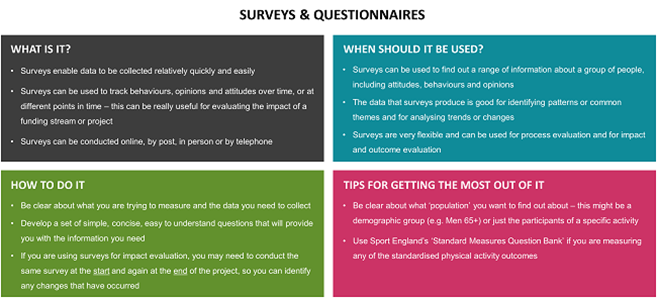2. choose your data collection methods and tools
There are lots of different ways you can collect data. You’ll need to choose the data collection methods and tools that are most suited to your funding stream or project based on the requirements you have set out in Steps 1, 2 and 3. If possible, speak to your funders, stakeholders, and your target audience and involve them in choosing suitable methods. This is particularly important if your audience has communication or accessibility needs. Examples of data collection methods include surveys, interviews, focus groups and participant observation.
We have developed an information pack which gives an introduction to the most commonly used data collection methods and tools, such as 'Surveys and Questionnaires':

This information pack will help you to decide on the best way to get the data that you need to collect - to download it click on the image above or use the links on the right.
We also provide guidance on designing evaluation that is accessible for audiences with communication or accessibility needs.
Sport England’s Question Banks
Sport England wants to work with other organisations to standardise the questions that are used to obtain some commonly collected data, such as the characteristics of project participants and how physically active people are. We have developed an adult question bank that sets out the standard questions that you should use when collecting this data from adults and another question bank to be used to collect data from children.
Sport England expects these standard questions to be used when this type of information needs to be collected, in all projects that involve our investment.
The questions are suitable for most adults and children, but you may need to adapt them for particular groups such as adults or children who might have difficulty understanding a question (e.g. where there are language barriers or people with impairments such as learning difficulties). See our Accessible Evaluation resources for more guidance on this.
Funding recipients will also need to think about the tools and methods to use to collect any additional data required to measure progress of outcome indicators, obtain information for learning, or to report to other funders, partners and stakeholders.
Recommended Actions
1. Choose the questions that are relevant for your M&E approach from the Sport England Question Banks.
2. Decide and document the methods and tools you will use to collect the data you need in the 'M&E Plan' template.
 purpose
purpose
 Process
Process



